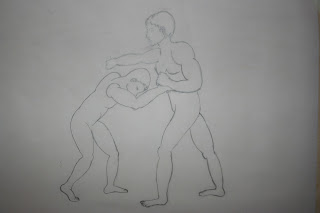 |
| Aside from being boring, and wretchedly "scanned," can you see what's wrong with this C- one? |
 |
| D. A similar error compounded by wildly incorrect perspective |
 |
| A! Excellent is as excellence does. |
 |
| A! |
 |
| A-, despite terribly unrealistic face and lack of complete BG reflection. Everything else is essentially perfect |
ASS #11
Description
Create an illustration for the story of Snow White. Research and design your characters and locations to fit the country/era in which you decide to set the story.
Your style must be 100% literal/realistic.
Illustrate the passage below using the 2-point perspective mirror construction you learned in class. We should see both the Queen and her environment reflected accurately in the mirror.
She must be shown from head to toe - and at least three other items must be seen in the room as well as reflected in the mirror. Don't forget: this illustration must show as much accurate reflection of objects as possible and will be graded accordingly.
Don't skip drawing the reflection of the walls of the room. I can't tell you how many drawings I've seen where the queen and the three objects were reflected, but nothing else, as if there were a low-hanging fog in the room.
Important Tip: Use the whole wall as the mirror until you get your reflections in place, then decide where to place the mirror frame to fit with your reflection.
(Also, rather than placing objects in the “real world” in the hopes that they will appear where you want in “Mirrorworld,” it’s easier to place them in Mirrorworld first and then use the usual process in the opposite direction to place them into the real world. This tip from Joko.)
Your line drawing should be 9" x 12" or larger at the same proportion. Keep it neat, clean, realistic and accurate. Your default line should be a single clean line. Contours should be weighted only if you can do it smoothly, without hairiness. Straight edges should be straight. Ensure that this drawing is as professional and precise as you are capable of producing. Add no value at this time.
INCLUDE A CLEAR OVERLAY SHOWING YOUR CONSTRUCTIONS. Flap it properly, with a long piece of tape across the back.
Snow White Text
News of Snow White's death sent the Queen rushing to consult her magic mirror. She fled to the top of the tallest tower and entered the secret chamber where all her terrible spells were boiled and bred.
Lighting a candle she locked the chamber door and turned to question the mirror that watched her silently from the far wall.
'Mirror, Mirror on the wall, who is the fairest of them all?'
There was a long silence as her reflection scowled back at her from within the glass.
Then, finally, the mirror spoke...
Here is a schematic that covers the main reflection schemes. For simplicity, not every point has its reflection plotted. This is made to demonstrate the appropriate use of the subdivision method in various situations. Note please that in cases such as points E, F and G, where the object is not using the same VPs as the mirror, each corner must be plotted independently.
And here is a way of checking your work as you go to eliminate the little inaccuracies that the above methods amplify. You may prefer the animated version,
here. (Wait for a second--the animation gives you a chance to study the setup.) The key insight here is the projection lines meeting their own reflections at the foot of the mirror plane. That will help you draw the reflection more accurately. You can go beyond that in some cases and find a Mirrorworld VP or two, which will
really make your drawing hang together.
JH






















































